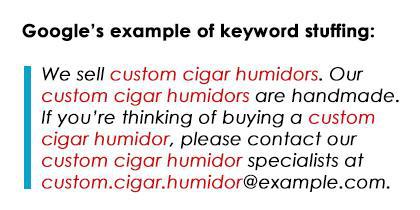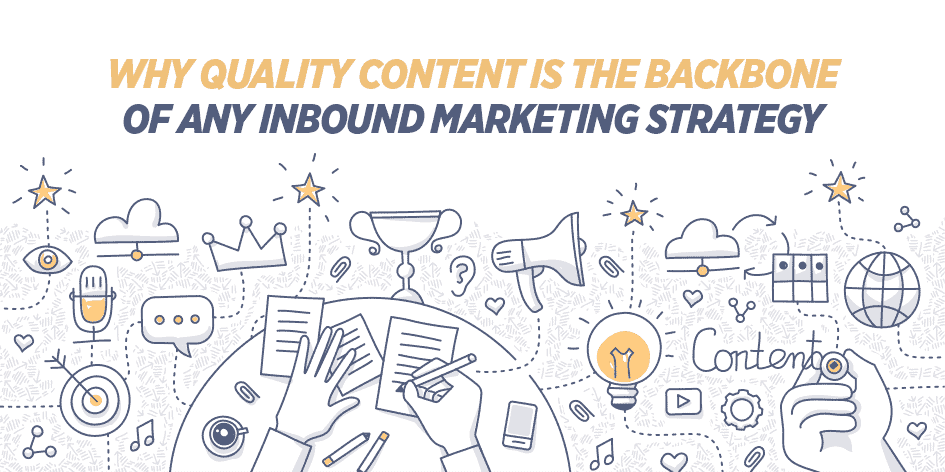Many brands that are new to inbound marketing struggle to understand just why content creation is such an invaluable element in any inbound marketing strategy.
Why do we need blog posts? What real value does this ebook provide? How do we know when the content is working?
We get these questions all the time, and we understand how difficult it can be, at first, to “get” content marketing. So we decided to put some of our answers into a blog post. Here are the reasons why quality content is the backbone of any inbound marketing strategy.
First: what’s “inbound marketing”?
Inbound marketing involves using tactics that help potential customers find your brand.
In other words, you’re not expending energy and resources sending marketing messages out to people who may not even be interested in your what you have to offer.
Instead, your focus is on strategies that attract customers to your website. That means creating great content, sharing relevant posts on social media, optimizing your site and content for SEO, etc.
This is a fundamental change from the way that companies used to understand marketing. Today, people don’t want to be interrupted. They don’t want banner ads advertising something they’ve never been interested in. A growing number are using ad blockers. Digital natives, or Gen Z, are especially good at tuning out anything that feels like an ad.
All this has meant that brands have had to change the way they sell themselves to potential customers. And in this brave new world, content is king.
Why content?
Simply put, inbound marketing does not work without content. How are you going to attract visitors to your website if you don’t have something for them to enjoy once they get there?
Relevant, valuable content is that something.
Inbound marketing does not work without content. #contentmarketing Share on X“Content” can mean a lot of things when it comes to inbound marketing. Here are just a few of the different types of content that brands use:
- Social media content – posts on different platforms as well as specialized content like Twitter moments, Instagram Stories, Facebook Stories, etc.
- Blog posts
- Ebooks
- Whitepapers
- Webinars
- Video – how-tos, explainer videos, brand awareness videos, educational videos, testimonials, etc.
- Live streams
- Infographics
If you’re working your strategy diligently, then your various pieces of content will all work in concert to draw potential customers to your blog, your social media pages, and ultimately, your website.
How is content marketing different from inbound marketing?
Content marketing and inbound marketing are very similar in a lot of ways. The premise of both is to bring customers in, rather than interrupting them with an ad for, say, shoes, when they’re browsing for something completely unrelated, like dental services or preschools.
The difference, though, is that content marketing is an element – albeit a crucial one – of inbound marketing. Without content marketing, you can’t have inbound marketing.
On the other hand, you can have a content marketing strategy without a full inbound marketing one. That’s because inbound marketing also includes things like website optimization, SEO strategy, email marketing, and social media strategy, among others.
Ideally, of course, you’d have a robust content marketing plan that’s embedded within a full inbound marketing strategy.
How can content help improve my SEO?
SEO, or search engine optimization, refers to the tactics marketers use to help brands get to the top of Google’s search results when people search for the thing that brand offers.
Content is invaluable for improving SEO. That’s because one fundamental element of SEO is keywords – using the right ones, in the right context, and in a natural, well-written manner.
It used to be that you could just include a specific keyword, like “pink lawn chairs” as many times as you could fit it into a piece of web copy – known as keyword stuffing – and that would boost your search ranking. You’d find web pages that looked like this:

That was before Google got smart.
Nowadays, Google can tell if you’re writing junky copy simply to improve your search ranking. And the algorithm doesn’t like that.
Instead, if you want to get to the top of the search rankings in your particular field, you need solid, well-written, and valuable content. You need content written for humans, not for search engines (although you do need to include good keywords in every piece of content to make sure Google can find you).
Another vital element of SEO is earning solid backlinks – in other words, inspiring other reputable sites to link to your content. Having a university, an industry leader, or a major influencer link to one of your blog posts or videos can have a huge impact on your search ranking.
The only way to earn these backlinks, of course, is to have great content.
What kinds of content do I need?
Really, you need to be creating at least three different types of content.
You need at least one long-form type – ebooks, whitepapers, and/or blog posts (1,200 words is ideal for a blog post today).
Then you need the short-form stuff – social media posts, lists of curated content, and/or shorter blog posts.
Finally, there’s the visual content – videos, live streams, and infographics.
If you don’t have the bandwidth to support creating all of these things right from the start, don’t worry. You can easily start with blog posts, and work your way up to the more resource-intensive types, like video.
Why do we need to continue creating content? Why can’t we just write a few ebooks?
It might seem as though loading up your site with great content, then calling it a day should work – at least for a year or two. Right? You’d think that as long as the content was useful, relevant, and well-written that it would continue to work for you without you having to do much.
There are a couple of reasons that this isn’t the case.
The first is basic: people want new, fresh content. They’re not going to keep clicking on the same blog post or whitepaper or video over and over, which means they’ll have less reason to come to your site. You’ll lose the chance to nurture those leads and turn them into customers.
In addition, if you don’t have new content to share regularly, you won’t attract new customers – which is a major reason that you’re creating content in the first place.
The second is that Google takes “freshness” into account when determining search rankings. The potential hows and whys of this are far too numerous for this blog post – for that, we highly suggest you read Moz’s epic post on the freshness factor – but in general, you can expect that turning out valuable, fresh content will have a positive impact on your search ranking.
How do I know if my content is working?
This is the million-dollar question. How do you know if your content is working? How do you know that you’re giving your readers what they want?
The first step is to check your analytics. See what your top entrance and exit pages are (what pages people are first coming to your website through, and what pages they’re leaving your website from).
Check your top 5 or 10 blog posts on a monthly basis. Are the same few consistently ranking high? Create a few more like them, or repurpose those posts into new forms of content like a video or an infographic.
Determine whether your content is working by running A/B tests on your headlines, images, or both. Share on XAnother good way to determine whether your content is working is to run A/B tests.
These are frequently done in email marketing, often with subject lines. You create your email, then you write two different subject lines. You send the email with the first subject line to one random sample from your email list; another random sample gets the other subject line.
Then you can compare the open rate of each email, and determine which subject line worked best.
You can do the same with your content. Write two different headlines for the same blog post, and share the post on the same channel at different times. Then see which headline worked best.
You could also apply this to images. Test the same content piece with two different images to see which performs better. Test the same video with two different headers.
The options are endless, and by paying attention to which headlines, images, headers, etc. are performing better, you’ll gain more insight into what works for your particular audience.
Still not convinced that content is key to building your inbound marketing strategy? Read our post “6 Tips for Creating Content That Converts.”









